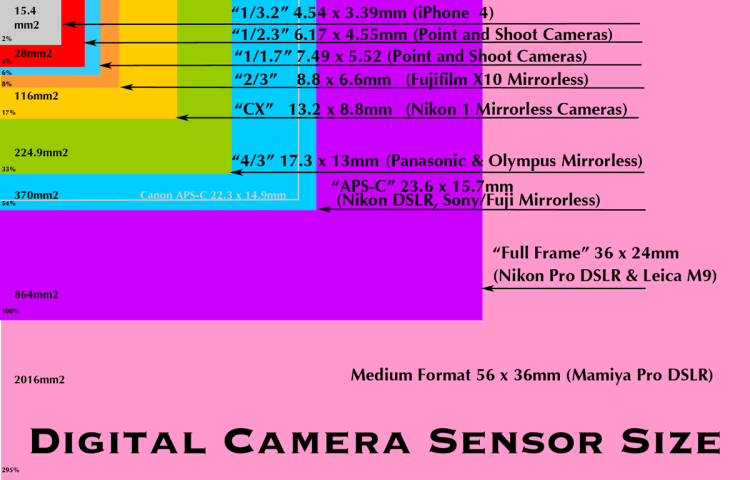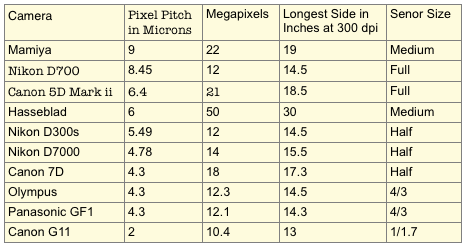Sensor Size and Pixel Size
You can not pick up a camera or smartphone without hearing about its megapixel count and at face value you might conclude the more megapixels the better. Megapixels do tell you the resolution or sharpness of the image you will get when you post it or print it, but it does not tell you about the quality. What effects the quality is the size of each pixel on the sensor, and the smaller the sensor the smaller the pixels. As pixels get smaller the cameras colour accuracy goes down, while noise and artifacts increase.So if you have a 20 megapixel camera and it has a “full frame” sensor the pixels are much larger than on an 20 megapixel APSC sensor that is 54% the size of a full sensor. Roughly speaking the individual pixels that record light will be half the size on the APSC sensor. The chart below gives you the relationship between the sizes of the different sensors. A “full frame” sensor is usually found in most professional cameras (unless they are medium format) and the APSC sensor is found in most DSLRs or Mirrorless cameras that people pick up at your local camera store.
 |
| copyright sassamatt.com |
The most revealing aspect of this chart is the percentage figure on the left hand size that shows that most point and shoot camera sensors are 4% the size of a full frame cameras and APSC cameras like the Fuji X-T1 or Nikon D7100 are 54% the size of a full sensor camera. If you own a 4/3″ camera then your sensor is 33% the size of a full sensor camera.
The Problem with Smaller Pixels
A 20 megapixel sensor can be describe as a surface on which there are 20 million small buckets, each bucket collects light (photons) and sends this sampling to a processor in the camera that then produces a picture. The smaller the buckets the smaller the sample it collects. The small the sample the more difficulty the processor has in creating an accurate image. So as the pixel size decreases less light is sampled making it more difficult to produce an accurate image. This is why larger cameras produce a clean looking photograph with accurate colour and smaller cameras produce cartoon like colours, have more noise, have more artifacts and inaccurate edges.
How Small is To Small
So how can you find a clear measurement of how big the pixels are when there are a multitude of sensor sizes and with different megapixel counts? The measurement that allows you to do this is pixel pitch. Pixel pitch is a measurement of the number of photons each pixel collects. Remember the fewer the photons, or the lower the pixel pitch number, the more the processor has to guess about the information coming from the sensor. The more guessing the camera does the more cartoony the edges and colours. Also the more guessing the more noise and artifacts that the camera introduces into your image.
You will notice that most of the professional cameras have on this list have a pixel pitch of approximately 5 or greater, which gives you some idea of a desirable pixel pitch
Conclusion
Finding out the pixel pitch of a camera you want to buy means you will be able to compare it with other cameras with different sensor sizes and megapixels. You will find that lower pixel pitches are fine for small internet photographs, but printing over 8 by 10 prints usually means you need a pixel pitch of at least 5 or more.
Keeping in mind picture quality can be effected by other things as well such as the quality of your lens, the manner in which you operate and shoot the camera, whether you shoot RAW or JPG and how you process your images. However sensor size is still key to determining the quality of your print and how big you can enlarge it.
Post Script
New sensor technology in the form of back illuminated sensors and sensors with copper substrate, can cause the pixels to gather more light.

No comments:
Post a Comment